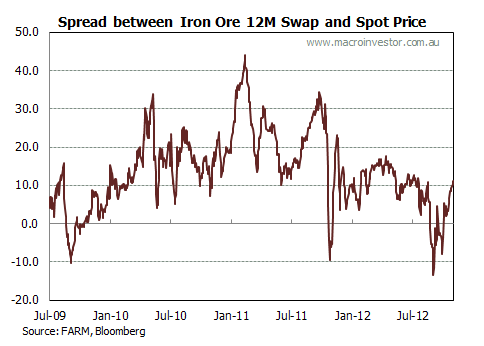
Here is yesterday’s iron ore price. It’s a war between the 12m swap, which rightly does not want to budge and the spot price, which just as rightly wants to rise. Here’s where we’re up to on the spread between them:

I’m still thinking that yesterday’s Indian news will be enough to push spot higher but there is no doubt there is lot’s of resistance here. For those that believe in such things (I lost faith a while ago), Baltic Dry Capesize rates are still falling and the underpinning rally in Chinese steel prices is still very muted (I’m working on a chart of this for tomorrow).
These are all themes taken up by the ANZ commodity team in their freshly released monthly update:
Strong iron ore price gains may be about to slow as an extensive short covering rally over the past two months runs its course. The immediate demand backdrop still looks shaky, with improving headline economic data offset by the overhang of excess steel supply. Steel price gains have been a lot less impressive suggesting most of the recovery in iron ore is coming from opportunistic arbitrage trading and steel mill restocking rather than a material improvement in demand. This seems consistent with key steel producer, Baosteel keeping monthly steel price contracts steady for November implying a lack of confidence in near term demand. The 4.3% jump in daily Chinese steel output through mid October (from early October) is encouraging, but comes immediately after a slow week long holiday period. Many steel mills are now baulking at iron ore prices above USD120 a tonne, complaining that steel price gains have not been strong enough to offset the higher raw material cost.
Coking coal has been a lot less positive than iron ore despite operating in the same end-user market. A lack of liquidity in the coking coal swaps market means investor interest has been much lower. Trade data also looks less appealing with Chinese coking coal imports falling by more than half in the past three months compared to a 10% increase in iron ore imports. We think this may revert in coming months with reports Chinese authorities forcing the temporary closure of many small unsafe mines to avoid any fatalities over the sensitive government leadership change. That said the biggest beneficiary may be Mongolia, which is exporting coal (to China) at much lower price levels than seaborne coking coal markets.
Thermal coal prices should start to firm over the coming months as Chinese power production ramps up for stronger heating demand. However, the gains will be capped by excess Chinese coal inventories (sitting somewhere between 26-29 days of supply). Chinese hydro-power production is also about 50% higher than 12 months ago. We would expect some support from the temporary closure of small unsafe mines, but the Chinese will be opportunistic in buying. Lower Chinese coal port stocks could also be misleading with the drop more attributable to the partial shutdown of the Datong-Qinhuangdao railroad over October 8-22 for maintenance (reducing coal railings to the ports by about 15%) – rather than a material pick-up in demand.
I’m less bearish short term and more bearish long.

